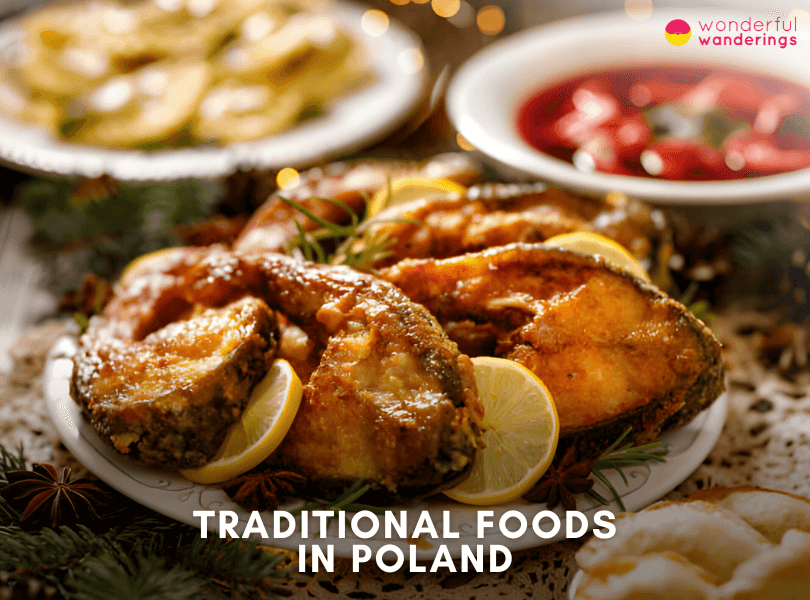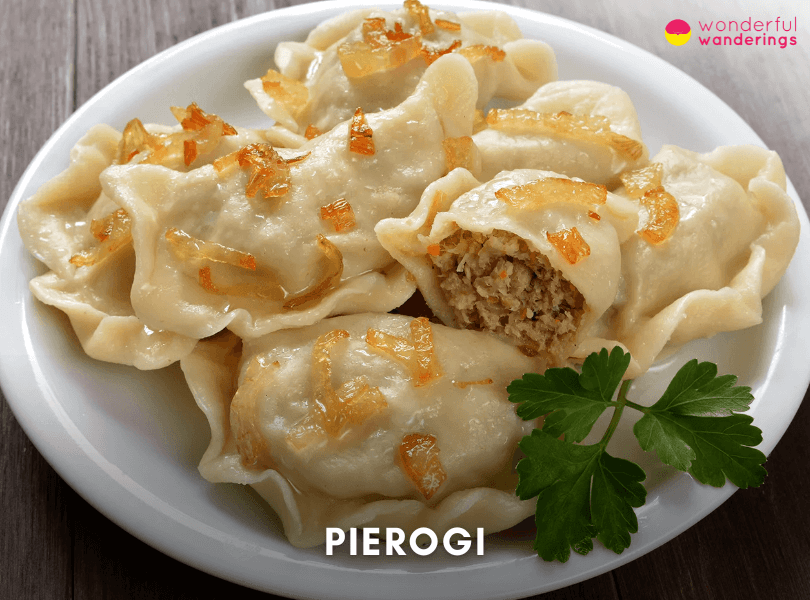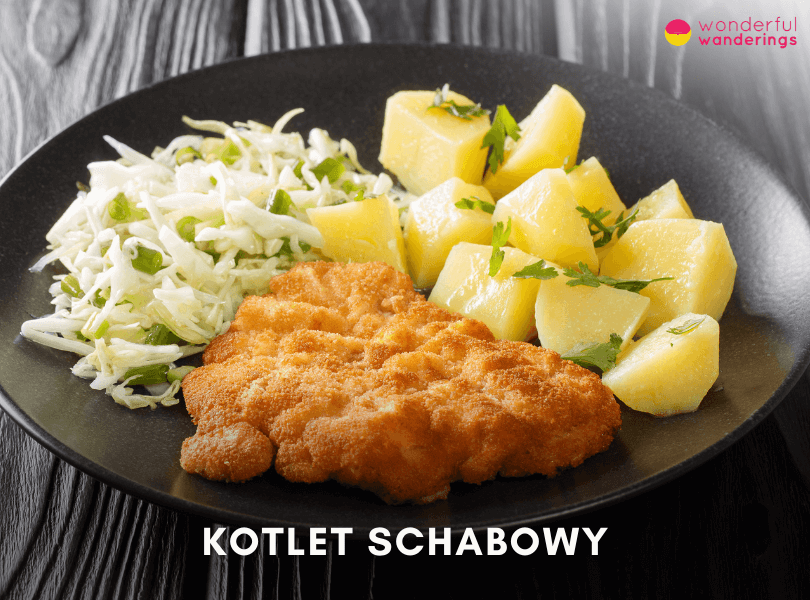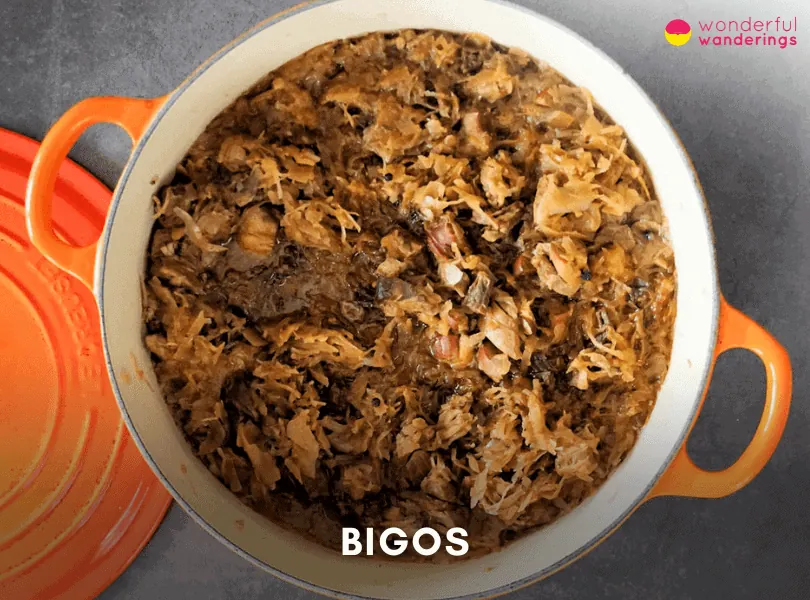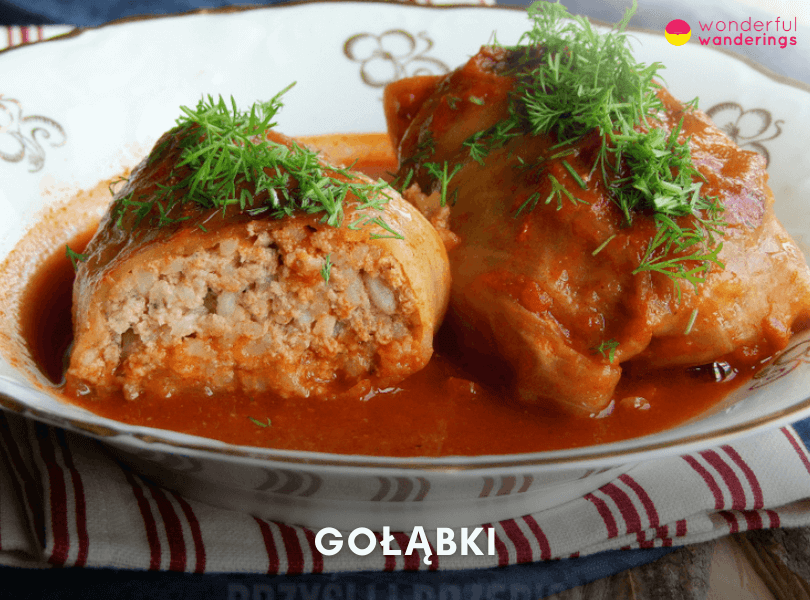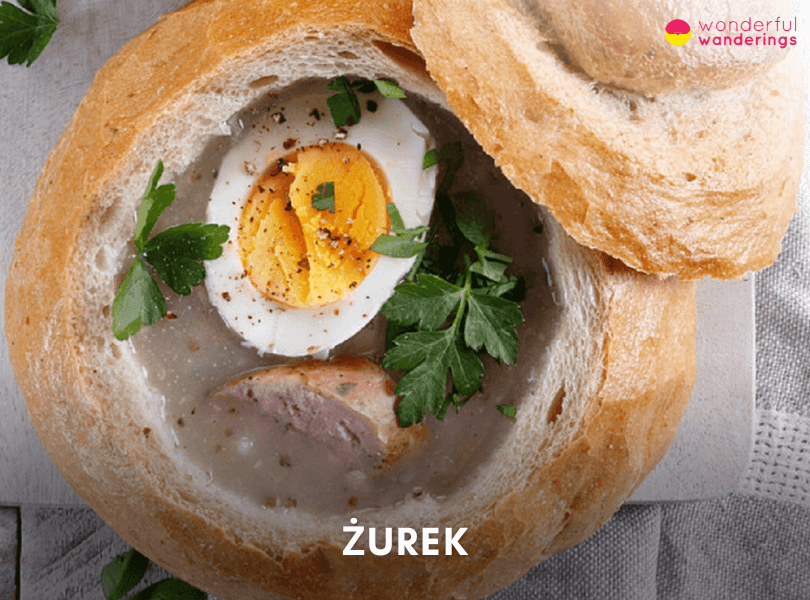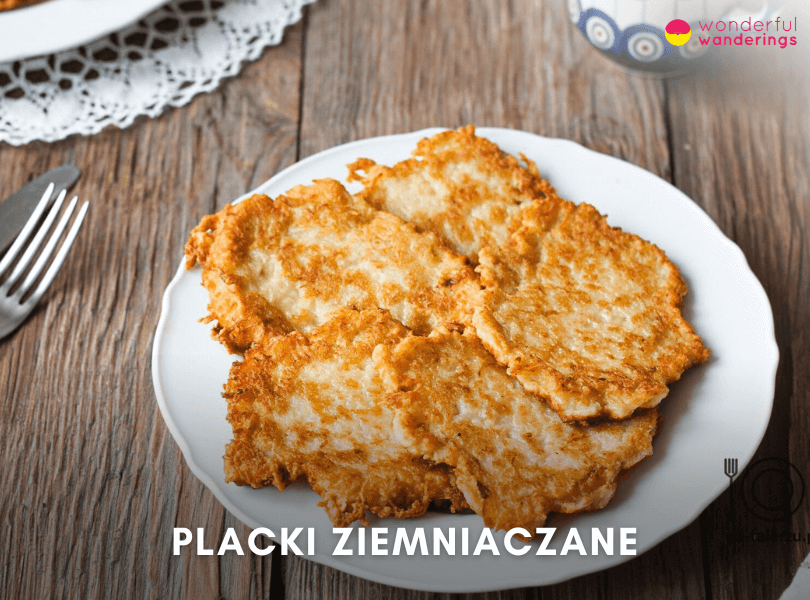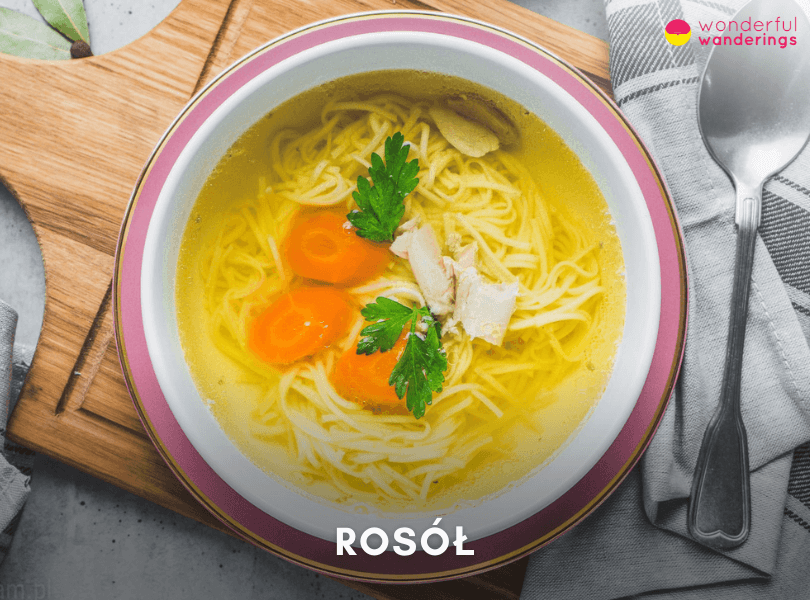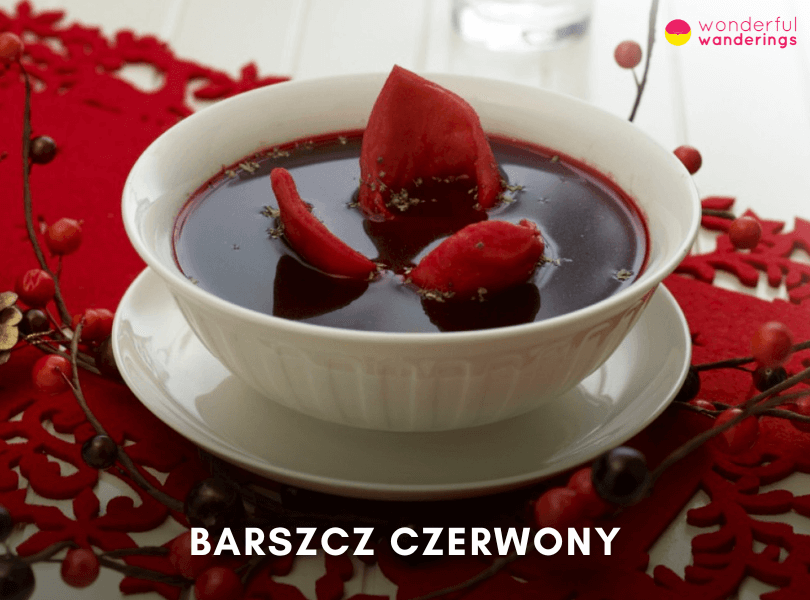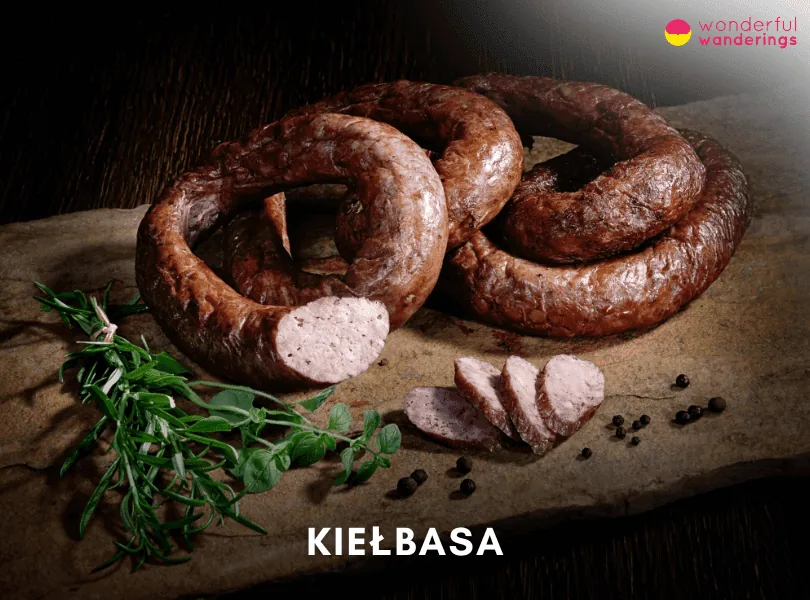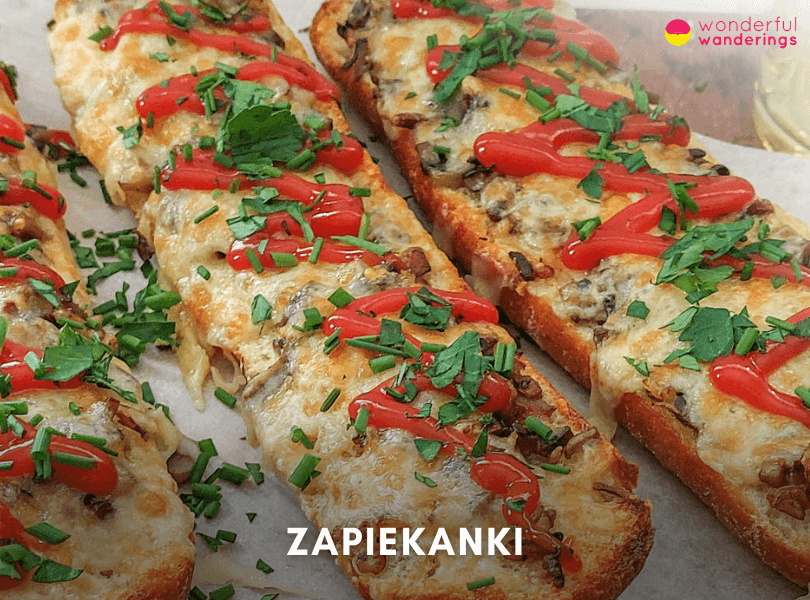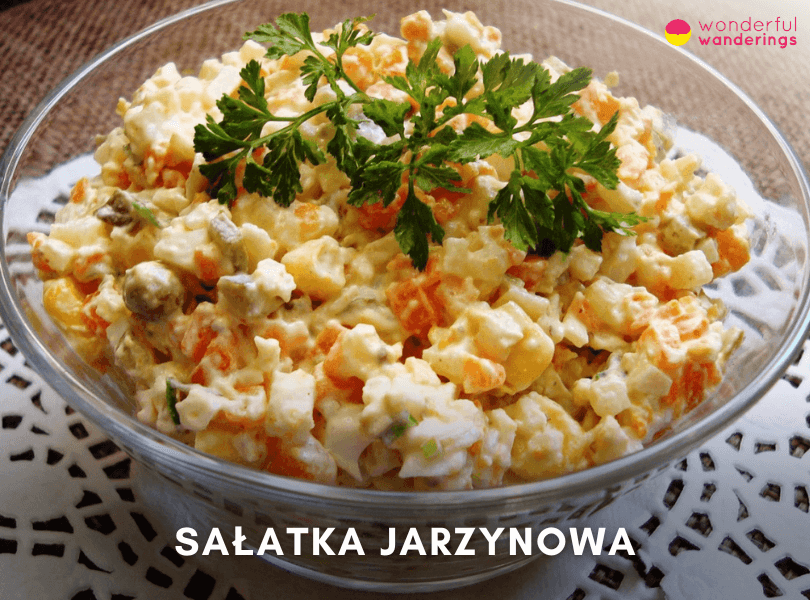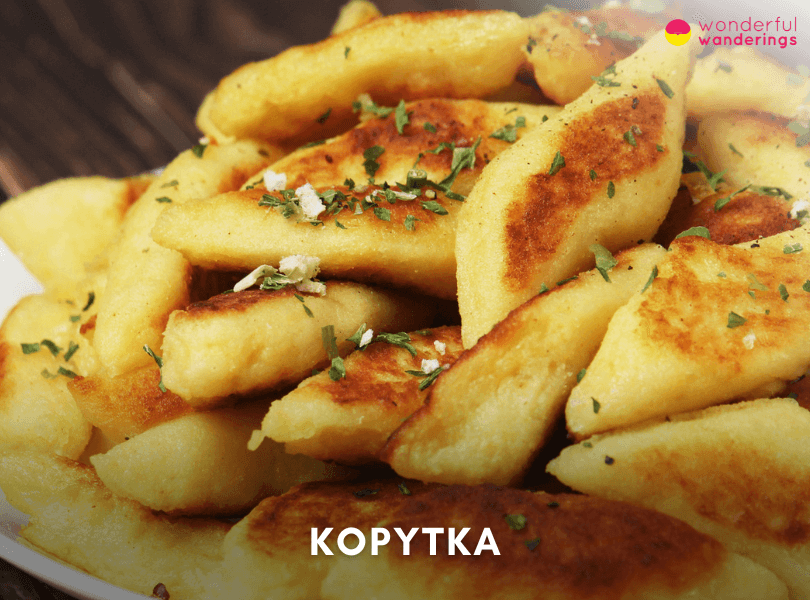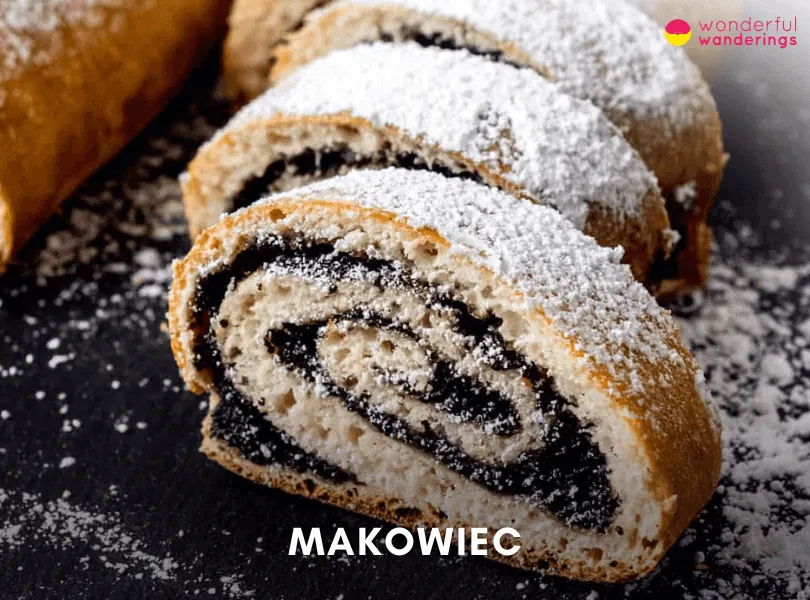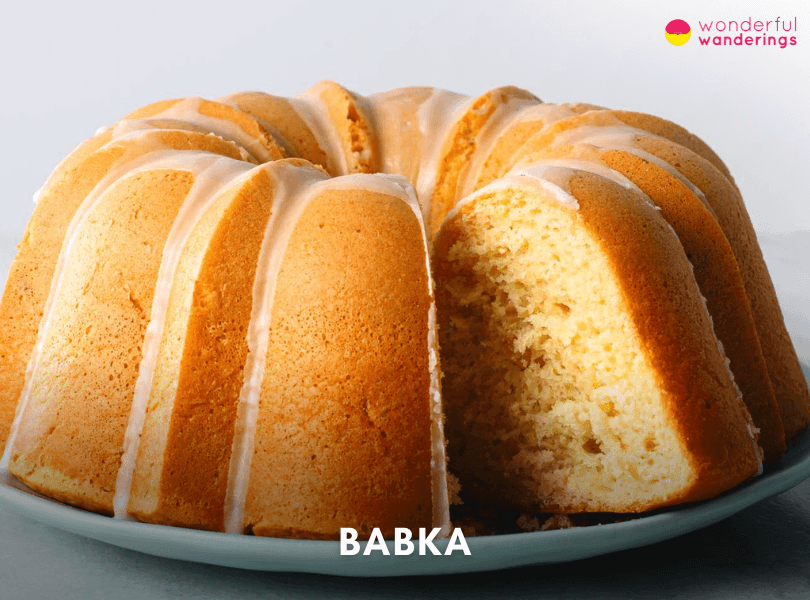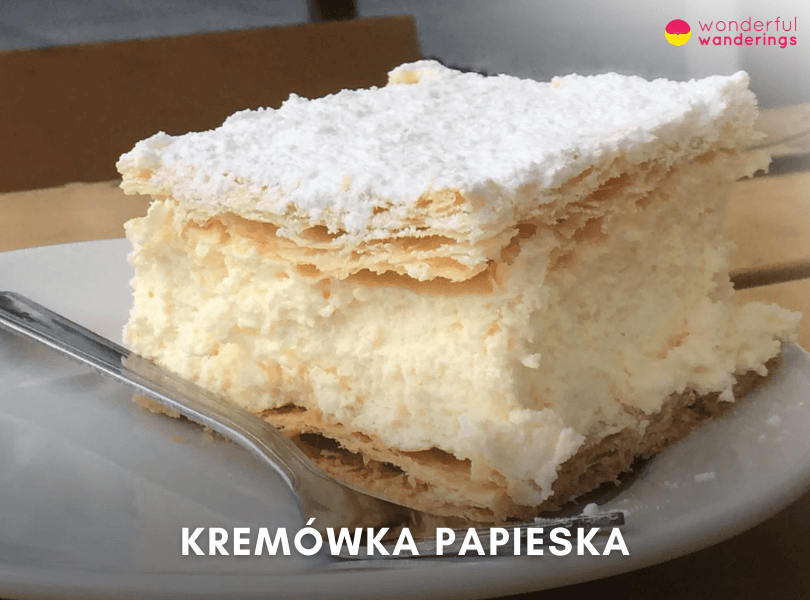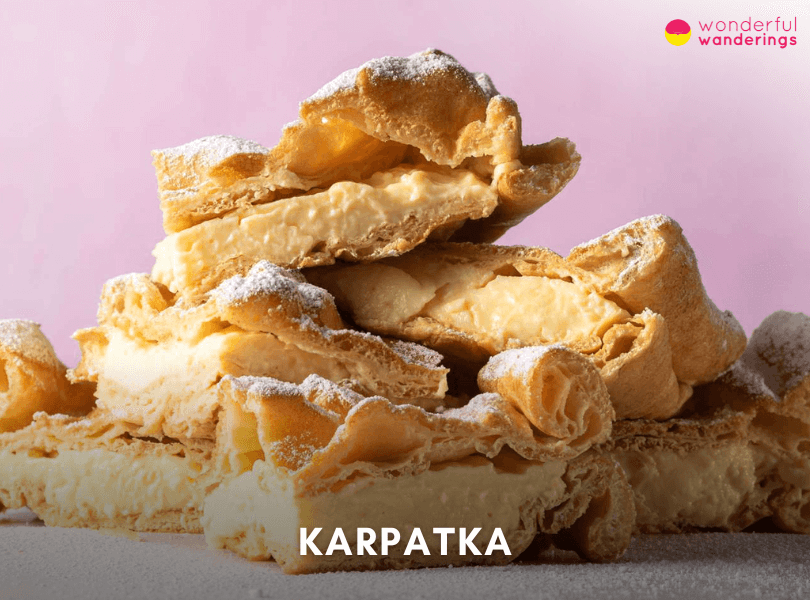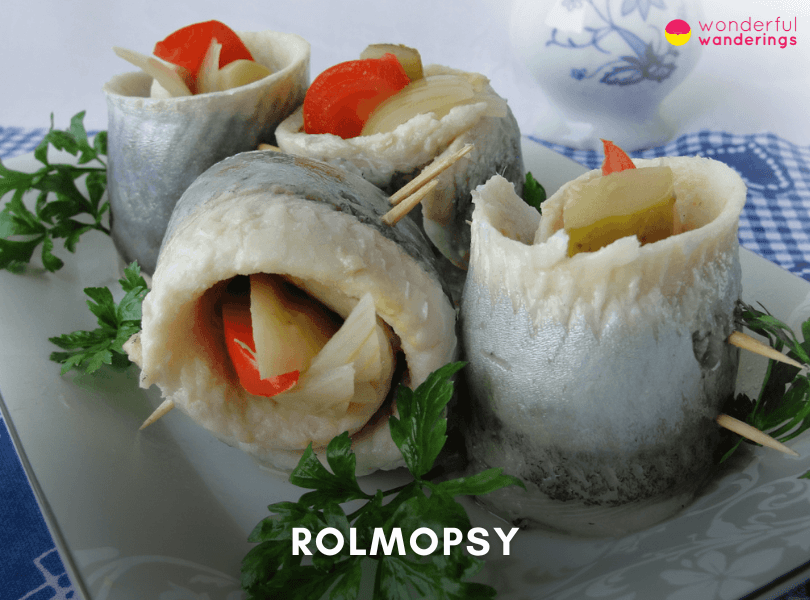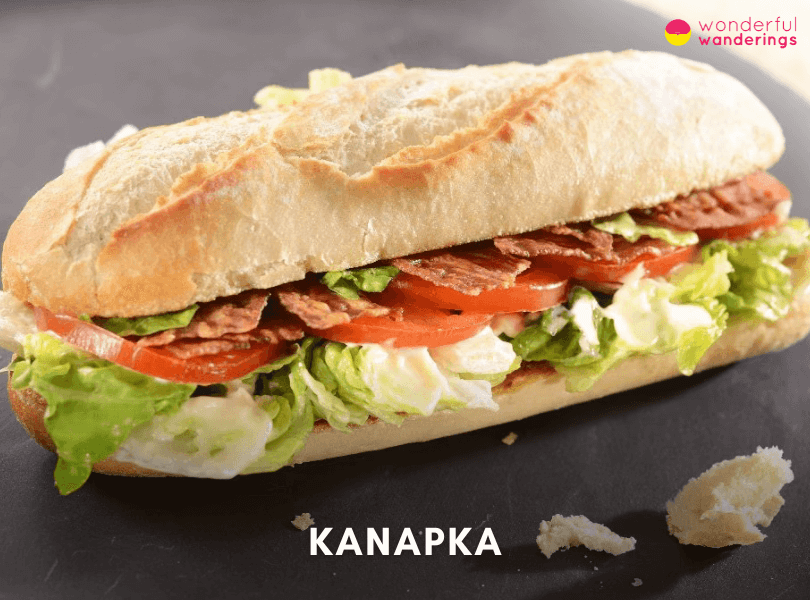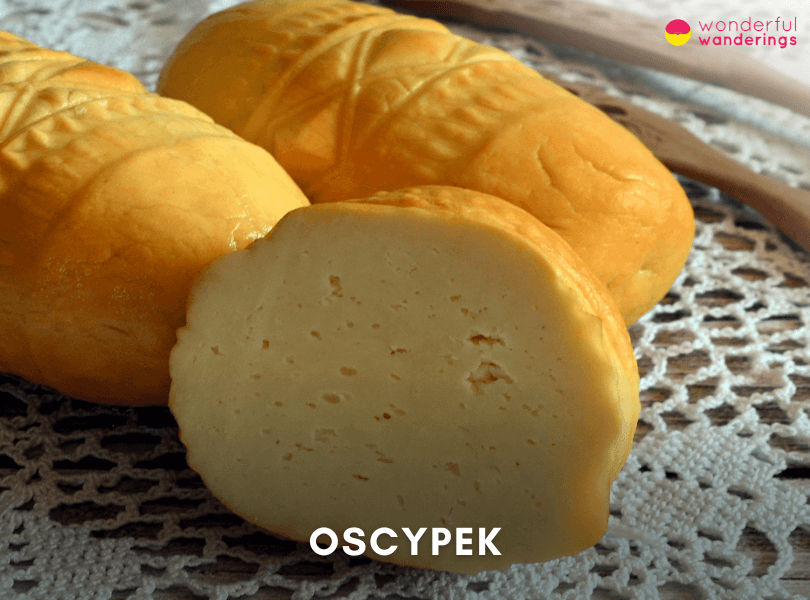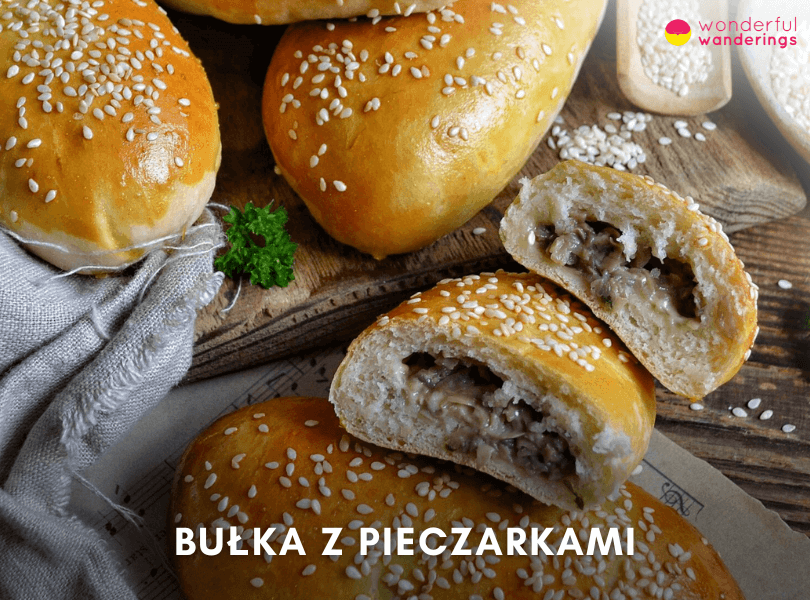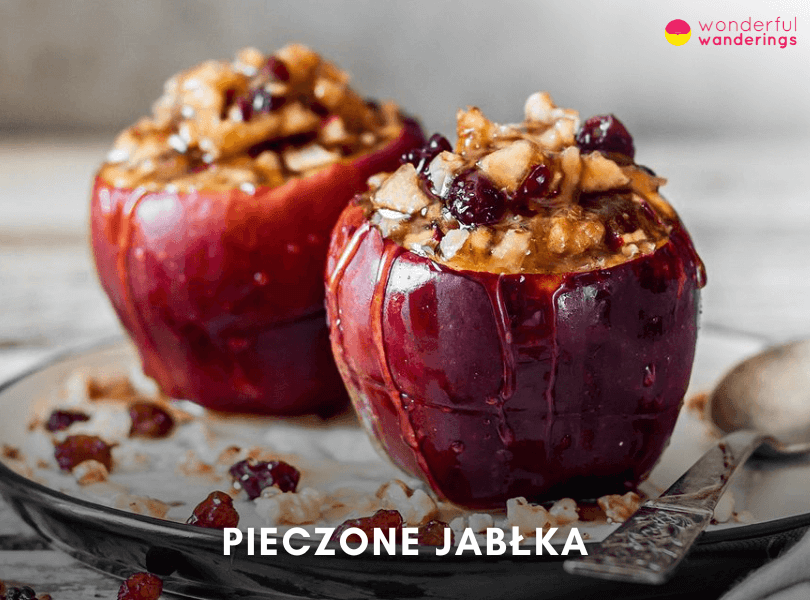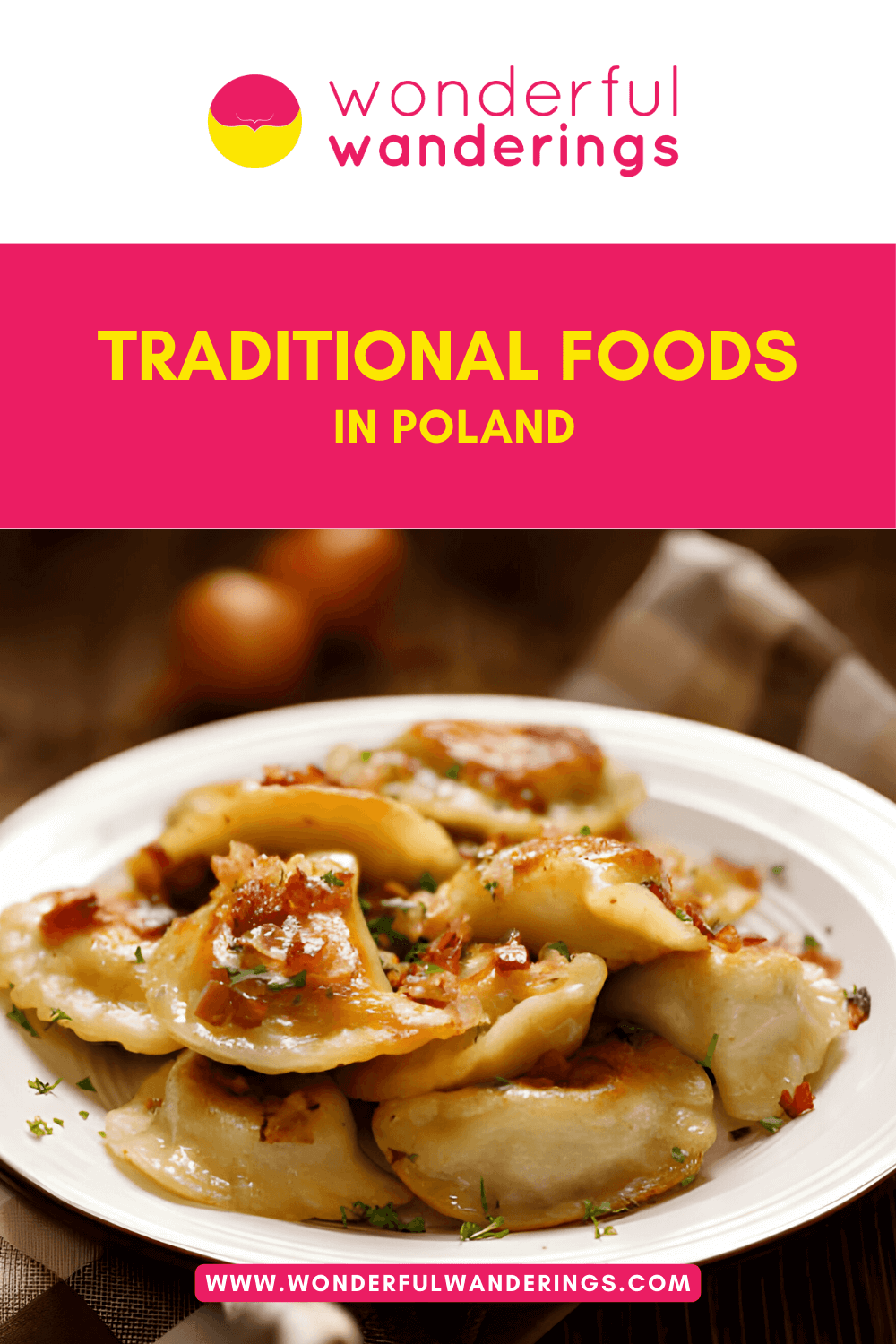Poland is a land of enchanting history and rich culture, where culinary traditions are as diverse as they are delightful. Imagine a table with dishes that tell tales of the country’s agricultural past and its fondness for hearty flavors. Picture Pierogi, those delightful dumplings filled with everything from cheese to fruit, a comfort food that warms the heart. Visualize Kotlet Schabowy, a succulent breaded pork cutlet that’s a nod to the classic schnitzel. Think of Bigos, a stew that marries the tang of sauerkraut with the richness of different meats, a dish that truly captures the spirit of Polish cuisine. Envision Gołąbki, tender cabbage leaves stuffed with meat and grains, a testament to the creativity of Polish cooking. Consider Żurek, a sour rye soup with a unique zest and fermented flavors. Ponder over Placki Ziemniaczane, crispy potato pancakes that offer a simple yet satisfying taste experience. Reflect on Rosół, a clear broth ideal of Polish comfort, enjoyed with noodles or dumplings. Imagine Barszcz Czerwony, a creamy beetroot soup showcasing the earthy bounty of Polish gardens. Each dish is a delightful chapter in Poland’s culinary story, reflecting the nation’s rich tapestry of regional and seasonal influences. A feast for the senses indeed!
Listed below are traditional Polish foods.
- Pierogi. Pierogi, a Polish dish, consists of dough filled with savory ingredients like meat, cheese or vegetables. It is boiled, pan-fried and often served with sauces like sour cream.
- Kotlet Schabowy. Kotlet Schabowy is a Polish breaded pork cutlet, similar to schnitzel, served with tartar sauce, breadcrumbs, sauerkraut and mashed potatoes.
- Bigos. Bigos, a traditional Polish stew, combines sauerkraut, cabbage, meat and sausage, spiced and served warm.
- Gołąbki. Gołąbki, a traditional Polish dish, features boiled cabbage leaves filled with minced meat, onions and rice or kasza.
- Żurek. Żurek, a traditional Polish soup, combines soured rye flour and meat, often served in a bread bowl.
- Placki Ziemniaczane. Placki Ziemniaczane, traditional Polish potato pancakes, are fried in butter or bacon fat and served with sour cream or applesauce.
- Rosół. Traditional Polish Rosół is a clear chicken soup, often served with capellini pasta and garnished with parsley.
- Barszcz Czerwony. Barszcz Czerwony is a traditional Polish beetroot soup, often served with sour cream and ravioli.
1. Pierogi
Pierogi, a traditional Polish dish, is a dough case filled with savory fillings like meat, cheese or vegetables, cooked by boiling and then pan-frying. Pierogi in Warsaw is best served in local places like Zapiecek, offering a modern twist to the traditional dish. Pierogi is healthy, with macronutrients, including carbohydrates, protein and minerals. Variations of pierogi include different fillings like potato, cheese, quark, sauerkraut, ground meat, mushrooms, fruits and berries. Pierogi complements common sauces like sour cream and fried onions. Pierogi’s ingredients are dough (made from flour, water and sometimes an egg or olive oil), mashed potatoes, fried onions and farmer’s cheese.
2. Kotlet Schabowy
Kotlet Schabowy, a Polish breaded cutlet, is a dish made from pork coated with breadcrumbs, similar to Viennese schnitzel or Italian cotoletta. It is served with tartar sauce, crispy breadcrumbs and a side of fried sauerkraut and mashed potatoes. The best Kotlet Schabowy in Warsaw is available in restaurants like Schabowy. It is a high-calorie dish with 490 calories per 100g serving, primarily from fat and protein; whether it is healthy depends on individual dietary needs and lifestyle. Variations of Kotlet Schabowy include Kotlet Mielony, a cutlet type including minced onions and mushrooms. It pairs well with caramelized onions, dill and applesauce. Ingredients to prepare Kotlet Schabowy are pork chops, eggs, milk, breadcrumbs, flour, salt, black pepper and sunflower oil.
3. Bigos
Bigos, a traditional Polish dish, is a hearty stew made from sauerkraut, white cabbage, meat and sausage, combined with different spices, served warm with bread or mashed potatoes. The best bigos in Warsaw are available in local restaurants like Restauracja Portretowa and Polka. Bigos is healthy due to its main ingredient, sauerkraut, which is fermented cabbage packed with beneficial probiotics. There are several variations of bigos, including bigos litewski, with the addition of apples. The essential ingredients for cooking bigos include sauerkraut, meat and sausage, with the addition of spices.
4. Gołąbki
Gołąbki, a traditional Polish dish, consists of boiled cabbage leaves wrapped around a filling of minced pork or beef, chopped onions and rice or kasza. Gołąbki in Warsaw is served at Gościniec Polskie Pierogi, a restaurant known for its traditional Polish meals. The dish is healthy due to its main ingredients. cabbage, rice and meat, especially when lean meat like turkey is used. Variations of Gołąbki include “lazy golubtsy” made with minced meat and a skinny version using ground turkey instead of pork or beef. Tomato sauce is a common accompaniment to Gołąbki, enhancing its flavor. Ingredients needed to prepare Gołąbki are medium white cabbage, ground meat (turkey or pork) and rice.
5. Żurek
Żurek, a traditional Polish soup, is made from soured rye flour and meat, boiled pork sausage, bacon or ham, served in an edible bread bowl, enhancing its hearty and satisfying nature. The best Żurek in Warsaw is at Polska Chata, a popular restaurant known for its traditional Polish cuisine. Żurek has health benefits, including improved digestion and a rich source of vitamins, thanks to the probiotics and enzymes it contains. Variations of Żurek exist across different regions, with some versions incorporating mashed potatoes, hard-boiled eggs or fermented oatmeal. Żurek is good, but a mild, creamy sauce balances its sour flavor. The ingredients needed to prepare Żurek include soured rye flour, meat (like pork sausage, bacon or ham), garlic, allspice and bay leaves.
6. Placki Ziemniaczane
Placki Ziemniaczane, a traditional Polish dish, is potato pancakes made from grated potatoes, egg, flour and salt, fried in butter or bacon fat. These pancakes are served with sour cream or applesauce, complementing any Polish meal. U Kucharzy in Warsaw is known for serving some of the best Placki Ziemniaczane in the city. The dish is high in carbohydrates and fried in fat and it contains beneficial nutrients from potatoes and eggs, making it a balanced part of a diet when consumed in moderation. Variations of Placki Ziemniaczane include different toppings like mushroom sauce or even a sweet version with icing sugar. The dish pairs well with different sauces, notably sour cream and applesauce. The ingredients to prepare Placki Ziemniaczane are potatoes, eggs, flour and salt.
7. Rosół
Rosół, a traditional Polish soup, is primarily based on meat broth, with the most popular variety being clear chicken soup, served with capellini pasta. Rosół in Warsaw is best served in traditional Polish restaurants like Bazyliszek and Przegryź. This soup is healthy due to its content of vitamins A and C, magnesium, phosphorus, gelatin and antioxidants, which are known to support the immune system. Variations of Rosół include Rosół Królewski, made with three types of meat and Rosół myśliwski, made with different wild birds and a small addition of roe deer meat. Rosół is garnished with chopped parsley leaves. The ingredients needed to cook Rosół include chicken, noodles, broth and vegetables like parsley, celery, carrot and leek.
8. Barszcz Czerwony
Barszcz Czerwony is a famous Polish beetroot soup enriched with vegetables and served hot with a dollop of sour cream, accompanied by ravioli or tortellini. Visitors can savor the best Barszcz Czerwony in Warsaw at restaurants like Czerwony Wieprz, which are known for their excellent meat dishes and soups. This soup has health benefits due to its high content of immune-boosting vitamin C, fiber, essential minerals like potassium and manganese and the nutrient betaine, helping protect cells and fight inflammation. Variations of Barszcz Czerwony include the creamy Barszcz Czerwony ze Śmietaną, combining beetroot flavors with chicken soup and cream. Barszcz Czerwony is a complete dish in itself. Essential ingredients for preparing this soup include beets, vegetables and often a souring agent like vinegar or lemon juice to achieve its tangy flavor.
9. Kiełbasa
Kiełbasa, a staple of Polish cuisine, is a meat sausage type in many forms, including smoked, boiled, baked or grilled and is garnished with fried onions. Kiełbasa in Warsaw is best served in places like Zapiecek and Ukryte-Hidden Bar and Bistro, where it is appreciated for its smoky and moist texture. Kiełbasa, while rich in nutrients like potassium, selenium, Vitamin A, iron and Vitamin B12, is high in fat, carbs and salt and should be consumed in moderation. There are numerous variations of Kiełbasa, including Kiełbasa Polska, Kiełbasa Krakowska and Kiełbasa Mysliwska, each with unique preparation methods and ingredients. Kiełbasa pairs well with different sauces, particularly those that complement its robust flavors. The ingredients needed to cook Kiełbasa include quality meat and spices, with garlic, black pepper, marjoram and coriander being common additions.
10. Zapiekanki
Zapiekanki, a Polish street food, originated in the 1970s due to limited private enterprise in the catering industry, becoming a popular choice among Poles for its simplicity and deliciousness. The best Zapiekanki are served toasted with different toppings, including traditional ones like mushrooms and cheese and are available at dedicated venues in Warsaw like Zapiexy Luxusowe, offering a twist on the classic by incorporating modern flavors. Zapiekanki are not healthy due to their high-calorie content and the presence of cheese and baguette. They do come in different versions, like “diabl” with spicy sauce “Gree” with feta cheese and “Hawaiia” with pineapple. Complementary sauces like ketchup enhance the flavor. The essential ingredients to prepare Zapiekanki are a baguette, mushrooms, cheese and optional toppings like ham, vegetables or other meats.
11. Sałatka Jarzynowa
Sałatka Jarzynowa, a traditional Polish dish, is a salad primarily composed of cubed boiled vegetables like carrots, parsley roots and potatoes and includes eggs, fermented cucumber and mayonnaise, served cold, with Polish sourdough bread. The best Sałatka Jarzynowa in Warsaw is subject to personal preference, as the dish varies from restaurant to restaurant. Dieticians have labeled it a “dietetic crim” due to its mayonnaise content despite its high vegetable content, suggesting it may not be the healthiest choice. Variations of Sałatka Jarzynowa can include the addition of an apple for a sweeter taste or pickles for a tangier flavor. It pairs well with different sauces, particularly those that complement its creamy texture. The ingredients needed to prepare Sałatka Jarzynowa include potatoes, eggs, fermented cucumber, peas, mayonnaise and optionally, leek or onions.
12. Kopytka
Kopytka, Polish potato dumplings, are made with mashed potatoes, egg and flour and are likened to Italian gnocchi. Kopytka is served with toppings like mushroom sauce, breadcrumbs, onions and bacon. The best Kopytka in Warsaw are found at local traditional Polish restaurants. Kopytka is a carbohydrate-rich food and its healthiness can depend on the toppings and accompaniments it is served with. Variations of Kopytka include those made with spinach for a green color and sweet Kopytka served with fruit, cheese, cinnamon powder or sugar. Sauces matching well with Kopytka include mushroom sauce, gravy and sauces made with onions and bacon. The ingredients needed to cook Kopytka are mashed potatoes, eggs and flour.
13. Makowiec
Makowiec, a traditional Polish cake, is a sweet roll filled with a rich, bittersweet poppy seed paste. Makowiec in Warsaw is best served at A.Blikle is a restaurant known for this dessert. As for its health aspects, poppy seeds provide manganese, calcium, copper, zinc, iron, linoleic acid (an omega-6 fatty acid) and fiber, but consuming large quantities may cause digestive issues. Variations of Makowiec may include additional fillings like minced walnuts or chestnuts. It is served with a glaze for added sweetness. The ingredients for Makowiec include milk, sugar, yeast, all-purpose flour, salt, egg yolks, butter, vanilla, poppy seeds and sugar.
14. Ptasie Mleczko
Ptasie Mleczko or Bird’s Milk, is a Central European confectionery originating in Poland, characterized by its soft, marshmallow-like interior covered in chocolate. Ptasie Mleczko is enjoyed as is, without any specific serving method. The best Ptasie Mleczko in Warsaw is found at many confectioneries, with E. Wedel being one of the most recognized producers. Ptasie Mleczko is a sweet treat not considered healthy due to its high sugar and fat content. Variations of Ptasie Mleczko include different flavors like vanilla, cream, lemon and chocolate. Ptasie Mleczko is enjoyed on its own. The ingredients needed to make Ptasie Mleczko include sugar, chocolate, powdered milk and gelatin or agar-agar.
15. Babka
Babka, a traditional Polish bread, is rich and often laced with rum syrup and icing, making it a beloved treat during Easter in Polish households. Babka is enjoyed in different forms, with some bakeries offering unique takes on the classic recipe. Many traditional Polish bakeries in Warsaw offer their versions of this beloved bread. Babka is rich in vitamins and minerals with risky components and must be consumed in moderation. Variations of Babka include different fillings and toppings, like chocolate or sugar glaze. It is often drizzled with icing or served with butter. The ingredients for Babka include bread flour, yeast, milk, butter, eggs and different flavorings like lemon zest and cinnamon, with raisins or dried cherries often added for extra texture and taste.
16. Sernik
Sernik, a traditional Polish cheesecake, is made using Polish ‘twarog’ cheese, known as ‘curd cheese,’ and an easy crust from scratch. Sernik in Warsaw is best served in Bistro Warszawa, where it is known for its light and fluffy texture. Sernik is considered healthy due to its main ingredient, twarog cheese, a good source of protein, calcium and vitamins like riboflavin and vitamin B12. Variations of Sernik include those flavored with vanilla, decorated with chocolate glaze, lemon/orange drizzle, streusel crumb topping or simply a dusting of icing sugar. It is served with powdered sugar dusting or a fruit sauce. The ingredients needed to cook Sernik include twarog cheese, eggs, sugar and an easy crust from scratch.
17. Kremówka Papieska
Kremówka Papieska, a Polish dessert, is a cream cake made of two layers of puff pastry filled with vanilla pastry cream. It is best served chilled and dusted with confectioners’ sugar. Numerous pastry shops in Warsaw offer this delicacy. Kremowka Papieska is a delightful treat but is unhealthy due to its high sugar and fat content. Variations of this dessert include a version with whipped cream, vanilla custard, meringue filling or double cream filling. Kremówka Papieska is enjoyed as is. The ingredients needed to make this dessert include puff pastry, milk, vanilla extract, egg yolks and sugar.
18. Karpatka
Karpatka, a popular Polish dessert, is a unique cake from uneven choux pastry layered with a rich, creamy vanilla custard filling. It is best served chilled, accompanied by coffee or tea, making it a delightful treat for different occasions, from birthdays to Christmas and Easter. The best Karpatka in Warsaw is savored at Pracownia Cukiernicza Zagoździński, a highly-rated bakery for its desserts. Karpatka is a dessert, not a health food, but it has eggs and milk, providing some nutritional value. Variations of Karpatka include different fillings types, like German buttercream, which adds a unique twist to the traditional vanilla custard. Karpatka is enjoyed as is, often dusted with powdered sugar. The ingredients to prepare Karpatka include butter, water, flour, eggs, sugar and vanilla extract for the choux pastry and milk, sugar, egg yolks and starch for the custard filling.
19. Rolmopsy
Rolmopsy, a traditional Polish dish, is made from pickled herring filets rolled into a cylindrical shape, often around a savory filling of onion and sliced pickled gherkin. It is served as a cold appetizer or side dish, especially during Christmas Eve. The best Rolmopsy in Warsaw is available in Kameralna, a local restaurant. Rolmopsy is a source of protein and B vitamins. Its health benefits are largely dependent on the individual’s diet and lifestyle. Variations of Rolmopsy may include different fillings or marinades, but the core ingredient remains pickled herring. A perfect match for Rolmopsy is a cold shot of vodka, which complements the tangy flavor of the dish. Ingredients to prepare Rolmopsy are pickled herring, onion, pickled gherkin, water, white vinegar and salt are needed.
20. Biszkoptowy
Biszkoptowy, a traditional Polish dish, is a unique blend of a sponge cake and an omelet made with eggs and flour. It is served with stewed berries, honey and crème fraîche, making it a sweet, creamy and fluffy treat, perfect for breakfast or brunch. The Sheraton Grand Warsaw in Warsaw is known for its biszkoptowy, offering a delightful culinary experience. Biszkoptowy is not naturally unhealthy. It is important to consider the toppings and serving size when assessing its nutritional value. Variations of biszkoptowy include different toppings like powdered sugar, maple syrup or jam. It pairs well with sweet sauces, particularly those made from fruits. The key ingredients for biszkoptowy are eggs and flour, with the fluffiness achieved by separating the eggs, beating the whites first, then adding the yolks and finally incorporating the flour.
21. Polish Breakfast Skillet
The Polish Breakfast Skillet is a hearty dish typically composed of kielbasa sausage, eggs and leftover noodles or potatoes, all fried together. It’s often served with crusty bread and a strong, black coffee, making it a filling and satisfying meal. The best Polish Breakfast Skillet in Warsaw is savored at Restauracja Zapiecek, a restaurant known for its traditional Polish food. The dish is high in calories but provides a good source of protein and carbohydrates, making it a substantial meal but not necessarily a low-calorie option. Variations of the dish include the Kielbasa Cabbage Potato Skillet and the Potato, Pepper and Kielbasa Skillet with Sauerkraut. Sauerkraut and mustard are two sauces that pair well with the Polish Breakfast Skillet, enhancing its flavors. Ingredients to prepare this dish include kielbasa sausage, eggs, onions and leftover noodles or potatoes are needed.
22. Kanapka
Kanapka, a Polish term, signifies a sandwich, typically open-faced and is a staple in Polish cuisine. It is served for breakfast, lunch or supper, with no significant variation based on the time of day. Mr. OH in Warsaw is a notable spot for enjoying a delicious Kanapka. Kanapka’s nutritional value depends on its ingredients, but it often includes a balance of proteins, carbohydrates and vegetables. Variations of Kanapka include the popular Zapiekanka, a warm, open-faced sandwich that is a common street food in Poland. Sauces such as ketchup, mayonnaise, horseradish, mustard or Polish garlic sauce are often used to enhance the flavor of a Kanapka. The ingredients for Kanapka include slices of bread or a roll, butter, vegetables like radish, tomato, cucumber, chives, ham or sausage, cheese or cottage cheese, boiled eggs and optional sauces like ketchup, mayo or mustard.
23. Oscypek
Oscypek, a traditional Polish cheese, is a smoked product made from salted sheep’s milk, exclusively crafted in the Tatra Mountains region of Poland. Oscypek is enjoyed sliced and served with lingonberry preserves. The best Oscypek in Warsaw is found at stands in shopping centers like Arkadia. Oscypek, a sheep’s milk cheese, offers many health benefits, including support for brain function, but it is also high in calories and fat, so moderation is key. Variations of Oscypek dishes include pan-fried Oscypek with fried onions and cranberries and grilled Oscypek served with homemade cranberry sauce. These dishes often pair well with cranberry sauce. The ingredients needed to prepare Oscypek include salt and sheep’s milk.
24. Bułka Z Pieczarkami
Bułka z pieczarkami is a Polish street food consisting of a bun filled with a mushroom stew, often champignons and is a popular choice in Warsaw. This dish is served hot and crunchy, with optional toppings like grated cheese, sausages or heavy cream and condiments such as ketchup and mustard. Restauracja Murzynek in Warsaw is noted for serving well-cooked mushrooms. The nutritional value of Bułka z pieczarkami varies based on the ingredients used, but it is not particularly healthy due to the potential high fat and calorie content from cheese and cream additions. Variations of the dish include different fillings like sausages or additional cheeses. Ingredients to cook Bułka z pieczarkami are a bun, mushrooms, onions and optional ingredients like cheese, sausages or cream.
25. Pieczone Jabłka
Pieczone Jabłka, a traditional Polish dish, refers to baked apples often prepared with spices, raisins and nuts. This dish is served as a dessert, sometimes complemented with cream or honey. The best Pieczone Jabłka in Warsaw is at Pogodna Restauracja & Drink Bar. Pieczone Jabłka is nutritious due to the health benefits of apples, including antioxidants, cholesterol-lowering properties and support for digestive health. Variations of this dish include different spices or additional ingredients like honey or cream. Pieczone Jabłka is complemented with cream or a scoop of vanilla ice cream. The essential ingredients for cooking Pieczone Jabłka are apples, spices, raisins and nuts.
What are the signature dishes of Poland that every visitor should try?
Listed below are the signature dishes of Poland that every visitor should try.
- Pierogi. Pierogi are crescent-shaped dumplings that are a Polish cuisine staple. They are boiled, fried or baked and come with different fillings, including cabbage and mushrooms, potato and cheese or simply meat. Sweet varieties filled with cottage cheese and raisins or fruit are also popular.
- Kotlet Schabowy. Kotlet Schabowy is a breaded and fried pork chop, a classic dish in Poland. It is served with mashed potatoes and pickled cucumbers, showcasing the country’s love for hearty, comforting meals.
- Bigos. Bigos, also known as Hunter’s Stew, is a traditional Polish dish made from fresh and fermented cabbage, different kinds of meat and Polish sausages. It is a must-have dish on the Christmas table of every Polish household.
- Barszcz Czerwony. Barszcz Czerwony or Red Borscht, is a beetroot soup served either hot or cold, with uszka, small dumplings whose name means “little ears”.
- Gołąbki. Gołąbki or cabbage rolls, are a beloved part of Poland’s culinary repertoire. They consist of cooked minced meat, with onions and mushrooms, wrapped in a leaf of white cabbage and stewed. They are typically served with boiled potatoes or bread and poured over with a thick, creamy tomato sauce.
- Kiełbasa. Kiełbasa or Polish sausage, is a staple of Polish cuisine. The most popular kinds include kabanosy, a thin, dried pork sausage with caraway seeds and Krakowska, a thick, smoked sausage with pepper and garlic from the Krakow region.
- Zapiekanki. Zapiekanki are open-faced sandwiches that are a popular street food in Poland. They are typically topped with sautéed white mushrooms, cheese and ham, then toasted until the cheese melts and bubbles.
- Żurek. Żurek is a sour rye soup that is a traditional part of Polish cuisine. It is served with boiled potatoes and sausage, providing a hearty and satisfying meal.
- Sałatka Jarzynowa. Salatka Jarzynowa is a traditional Polish vegetable salad made with boiled vegetables, eggs and pickles, dressed in a creamy mayonnaise-based dressing. It is a staple during festive occasions like Easter, family gatherings and picnics.
- Kopytka. Kopytka, likened to Italian gnocchi, is a classic Polish dish made from potatoes and flour. These small, pillowy dumplings are typically served with different sauces or stews, showcasing Poland’s tradition of hearty, comforting meals.
- Makowiec. Makowiec or Poppyseed roll, is a popular sweet food in Poland. It is a rolled-out sweet yeast bread filled with a rich poppyseed paste, enjoyed during festive occasions.
- Ptasie Mleczko. Ptasie Mleczko is a unique Polish dessert described as a mix between a marshmallow and mousse. These rectangular-shaped pieces are covered in chocolate and come in different flavors, including vanilla, chocolate, strawberry, coconut and caramel.
What foods are a must-try for first-time visitors in Poland?
Listed below are the foods that are a must-try for first-time visitors in Poland.
- Pierogi. Pierogi are traditional Polish dumplings filled with various ingredients such as potato and cheese, meat, vegetables or fruit. They can be boiled or fried and are often served with a topping of sour cream, butter or fried onions. Pierogi is a versatile dish and can be enjoyed as a main course, a side dish or even as a dessert. They are a beloved and iconic part of Polish cuisine, offering a delicious and satisfying dining experience. Pierogi are a must-try for first-time visitors to Poland.
- Bigos. Bigos, known as “hunter’s stew” is a hearty dish made with sauerkraut, fresh cabbage and various meats such as pork, beef and sausage. It is typically cooked slowly to develop rich flavors and is often seasoned with dried mushrooms and spices. Bigos is considered Poland’s national dish and is popular during the winter months. Its complex and savory taste makes it a favorite among locals and visitors alike, offering a comforting and satisfying dining experience. Bigos is highly recommended for first-time visitors looking to sample an authentic Polish staple.
- Żurek. Żurek is a traditional Polish sour rye soup made with fermented rye flour, meat (such as sausage or bacon) and hard-boiled eggs. It is often served in a bread bowl, adding to its unique presentation. The sour flavor of the rye combined with the richness of the meat creates a distinctive and hearty soup that is popular in Poland, especially during Easter. Żurek is a beloved comfort food that provides a warm and flavorful culinary experience. Żurek is a must-try dish for first-time visitors wanting to taste Polish soup.
- White Polish Sausage. White Polish sausage, known as “biała kiełbasa” is a traditional Polish sausage made from pork. It is lightly seasoned and parboiled, giving it a distinctive white color. The sausage is then grilled or fried and typically served with fried onions, sauerkraut, mustard, horseradish and rye bread. This dish is a staple of Polish cuisine, often enjoyed during festive occasions such as Easter and Christmas. The combination of the smoky, savory sausage with the tangy sauerkraut and zesty mustard and horseradish creates a delicious and satisfying flavor profile, making it a must-try for visitors looking to experience authentic Polish cuisine. White Polish sausage is highly recommended for first-time visitors.
- Chocolate Babka. Chocolate Babka is a Polish dessert that consists of a rich chocolate pound cake filled with cherries and covered in a warm, thick chocolate glaze. Chocolate babka is a beloved treat in Poland, often enjoyed during special occasions and holidays. Chocolate babka is a must-try dessert for first-time visitors looking to indulge in authentical Polish dessert.
What are the traditional desserts in Poland?
Listed below are the traditional desserts in Poland.
- Babka. Babka is a sweet treat savored during Easter Sunday in Poland. This dessert is a sweetened yeast cake baked in a bundt mold, giving it a distinctive ring shape. It is a versatile dessert flavored with different ingredients, like chocolate, fruit fillings or nuts and is enjoyed by locals and visitors.
- Szarlotka. Szarlotka, known as the “Polish apple pie” is a popular dessert found almost anywhere in Poland. It is made with a sweet shortcrust pastry layer, a filling of tart apples and a crumbly topping. This delicious treat is considered a country’s favorite and common in Polish bakeries and restaurants. It is a perfect dessert in autumn during the apple season.
- Sernik. Sernik or Polish cheesecake, is one of the most popular desserts in Poland. It is made with twaróg, a fresh cheese type, raisins and dried fruits. There are many varieties of Sernik, some baked, some unbaked. It is enjoyed year-round and is a staple in many Polish homes and restaurants.
- Kremowka Papieska. Kremowka Papieska, known as Napoleonka, is a traditional Polish dessert with two layers of puff pastry filled with a rich custard cream, dusted with powdered sugar on top. It is known for its creamy texture and delicate balance of flavors. Kremowka Papieska is a popular choice for celebrations and special occasions in Poland.
- Karpatka. Karpatka or Carpathian Mountain Cream Cake, is a unique Polish dessert resembling the rugged peaks of the Carpathian Mountains. It is made of two layers of choux pastry filled with a sweet vanilla custard cream. The cake top is dusted with powdered sugar, enhancing its mountain-like appearance. Karpatka is a beloved dessert in Poland.
What are the best starters or snacks to eat in Poland?
Listed below are the best starters or snacks to eat in Poland.
- Pasztet. Pasztet is a Polish pâté made from ground meat, liver, fat, bread and spices, served cold and spread on bread. It is a staple in Polish cuisine, enjoyed during the holiday season but consumed year-round as a hearty snack. Pasztet varies in texture and flavor, with some versions including mushrooms or herbs for added depth. This dish reflects the Polish tradition of utilizing all parts of slaughtered animals, ensuring nothing goes to waste.
- Krokiet. Krokiet is a savory Polish croquette, a breaded roll filled with meat, cabbage, mushrooms or cheese, deep-fried to a golden crisp. It is commonly served with a side of clear beetroot soup or enjoyed as a filling snack. Krokiet’s origins are traced back to French cuisine, thoroughly adopted into Polish culinary traditions and found at local eateries and street vendors.
- Smalec. Smalec is a traditional Polish spread made from rendered pork fat, enriched with onions, apples and spices. It is smeared on thick bread slices and garnished with pickles or fresh herbs. This flavorful and satisfying starter is common on Polish tables, especially in rural areas where it is a hospitality symbol.
- Ryba po grecku. Ryba po grecku, meaning “Greek-style fish” is a uniquely Polish dish with fried fish filets covered in a rich vegetable sauce. The sauce is made with carrots, celery, onions and tomato concentrate, creating a sweet and tangy complement to the fish. Ryba po grecku is served during Christmas Eve dinner and is available in restaurants as a popular starter year-round.
- Rolmopsy. Rolmopsy is Polish herring rolls featuring pickled herring filets wrapped around a pickled vegetable filling, like onions or gherkins, marinated in a vinegar-based solution, which imparts a sharp and appetizing flavor. These starters are a common component of the traditional Polish zakąska, a selection of small dishes meant to accompany vodka. They are widely available in Poland’s supermarkets and delis.
What are the best foods to eat for breakfast in Poland?
Listed below are the best foods to eat for breakfast in Poland.
- Semolina Porridge. Semolina Porridge is a classic Polish breakfast dish. It is a creamy, warm cereal made from semolina flour, sweetened with sugar or honey. This porridge is a comforting and filling start to the day, providing a good energy source for morning activities. It is a common sight in Polish homes and is enjoyed throughout the year.
- Polish Apple Pancakes. Polish apple pancakes are a traditional Polish breakfast treat. They are made by dipping apple slices in pancake batter and frying them until they are crispy on the outside and fluffy on the inside. The pancakes are then dusted with powdered sugar and drizzled with syrup, creating a sweet and satisfying breakfast dish. It is especially popular during the apple harvest season.
- Biszkoptowy. Biszkoptowy is a unique Polish breakfast dish that blurs the line between omelet and sponge cake. It is made with eggs and flour, then topped with stewed berries, honey and crème fraîche. The dish is fluffy and sweet, making it a delightful breakfast treat. It is enjoyed throughout the year, particularly during berry season.
- Polish Breakfast Skillet. Polish breakfast skillet is a hearty combination of kielbasa, potatoes, peppers, onions and cheese, all bound together by creamy scrambled eggs. It is a complete meal, served with rye bread for an extra-filling breakfast. This skillet is a popular choice for breakfast in Poland, especially during the colder months when served warm.
- Kanapka. Kanapka or Polish open-faced sandwiches, are a staple in Polish breakfasts. They are enjoyed in the morning and as a snack or supper. These sandwiches are topped with different ingredients, like cheese, ham, veggies or Polish sausage. Kanapka reflects the Polish preference for simple, high-quality ingredients and is common in Polish homes and cafes.
What are the best street foods in Poland?
Listed below are the best street foods in Poland.
- Zapiekanka. Zapiekanka, called Polish pizza, is a toasted open-faced sandwich that originated in the 1970s. It consists of a baguette sliced in half, topped with mozzarella cheese, sliced button mushrooms, onions, garlic butter and ketchup. Some variations include additional toppings like bell peppers, ham, bacon or kielbasa sausages. This popular street food is served at street stalls throughout Poland.
- Pierogi. Pierogi are crescent-shaped stuffed dumplings, a staple of Polish cuisine, filled with different ingredients, including vegetables, meat or even sweet fillings for a dessert version. Pierogi are traditionally served on holidays but have become a popular street food. They are boiled or pan-fried until golden brown and are served with sour cream or a sprinkling of chopped parsley.
- Oscypek. Oscypek is a smoked cheese made of salted sheep milk, produced exclusively in the Tatra Mountains region of Poland. This spindle-shaped cheese is enjoyed sliced or pan-fried. It is a traditional holiday cheese in some European countries known for its decorative appearance.
- Obwarzanek Krakowski. Obwarzanek Krakowski is a ring-shaped braided bread that is a popular street food in Poland. It is an excellent choice to start the culinary journey in Poland, enjoyed as a snack or a quick meal on the go.
- Bułka Z Pieczarkami. Bułka Z Pieczarkami, known as Bułka Po Warszawsku, is another popular Polish street food. It is a sandwich filled with mushrooms and other ingredients. This street food is an option for a quick and satisfying meal.
What is the top vegan food in Poland?
Listed below are the top vegan foods in Poland.
- Pierogi. Pierogi are a staple in Polish cuisine. These vegan dumplings are a dairy-free take on this popular dish, filled with creamy potato and tofu. The dough is handcrafted, stuffed with the filling, boiled and pan-fried. Pierogi are a versatile dish enjoyed as a snack or a main meal, a favorite among locals and tourists.
- Barszcz. Barszcz is a traditional Polish soup that is naturally vegan. It is a hearty and warming dish, enjoyed in colder months. The soup has tart, sour flavors, authentic to Polish cuisine. It is served with crusty Polish sourdough bread for a complete meal.
- Placki Ziemniaczane. Placki Ziemniaczane is a classic Polish dish that can easily be made vegan. These pancakes are made from grated potatoes and are typically fried until they are crispy on the outside and soft on the inside. They are a popular street food in Poland and enjoyed as a snack or a main dish.
- Gołąbki. Gołąbki or stuffed cabbage rolls, is a traditional Polish dish made vegan. The cabbage leaves are filled with grains and vegetable mixture, then rolled and cooked until tender.
- Pieczone Jabłka. Pieczone Jabłka is a traditional Polish dessert that is naturally vegan. The apples are baked with raisins, nuts and spices, creating a nutritious and comforting dish. This dessert is a popular choice in restaurants across Poland and is a delightful way to end a meal.
What are the dining customs or etiquette in Poland?
Polish dining customs and etiquette involve many practices and traditions. The seating arrangement at a Polish table is predetermined, with the most senior or honored guests entering rooms and being served first at the table. It is customary to wait for everyone to be seated before beginning to eat as a sign of respect for fellow diners. In some cases, guests may be asked to remove their shoes before entering a home. When dining in a restaurant, diners may have to share a table in informal settings and it is polite to act as if seated at a private table without engaging in forced conversation. Calling wait staff should be done by making eye contact rather than calling out or gesturing. Toasts are an integral part of Polish dining, with the most common toast being “na zdrowi” (to your health); maintain eye contact during toasts from the moment the glass is raised until it is placed back on the table. Multiple toasts can occur throughout a meal. The person who extends the invitation pays the bill, although the guests are expected to make an effort to contribute. Men traditionally rise when women enter the room and it is polite for them to allow women to enter rooms ahead of them. Trying at least a bite of all dishes is recommended and praising the food prepared by the host is considered obligatory. Meals are not the time for making business decisions and Polish associates should give cues. Diners should follow the common European cutlery use style, keeping the fork in the left hand and the knife in the right without switching. It is important to embrace the regional cuisine and show appreciation for the dishes served, as this is a way to respect and enjoy the rich culinary culture of Poland.
What local ingredients are commonly used in Poland?
Listed below are the local ingredients that are commonly used in Poland.
- Pork. Pork is a primary ingredient in Polish cuisine and is used in many dishes. It is especially common in the form of sausages, known as kiełbasa, a staple in Polish meals. The country’s love for pork is rooted in its agricultural history, where pig farming was widespread.
- Cabbage. Cabbage is a versatile vegetable in Polish cooking, used in soups, stews and side dishes, fermented to make sauerkraut, a key ingredient in the traditional dish bigos, known as hunter’s stew. Fresh cabbage is used in dishes like gołąbki, stuffed with meat and rice.
- Potatoes. Potatoes are a staple in Polish cuisine, used in different dishes, from soups to dumplings. They are served as a side dish or used as a filling for pierogi, a dumpling type. Potatoes are used to make placki ziemniaczane, a potato pancake type.
- Beetroot. Beetroot is a common ingredient in Polish cuisine used in soups and salads. It is most famously used to make barszcz, a sour soup that is a Polish cuisine staple. Beetroot is also pickled or boiled and served as a side dish or salad.
- Cream. Cream is frequently used in Polish cooking and added to soups to give them a rich, creamy texture. It is used in desserts and sauces. The use of cream in Polish cuisine reflects the country’s dairy farming traditions.
- Mushrooms. Mushrooms are a popular ingredient in Poland, used in many dishes, from soups to fillings for pierogi. Poland has different edible mushrooms, including porcini and chanterelles. These mushrooms add a rich, earthy flavor to dishes.
- Sausages. Sausages or kiełbasa, are a staple in Polish cuisine, used in many dishes, from soups to main courses. The sausages are made from different meats, but pork is the most common.
- Rye. Rye is a common grain in Poland, used in breads and soups. It is most famously used to make żurek, a sour rye soup that is a comfort food in Poland. Rye bread is a Polish household staple.
- Cheese. Cheese is used in many Polish dishes. One notable type is oscypek, a smoked cheese made of salted sheep milk produced in the Tatra Mountains region. It is used as an ingredient in meat dishes, salads or as a snack.
- Herbs and Spices. Herbs and spices flavor many Polish dishes. Commonly used herbs include dill, parsley and marjoram. Spices like pepper and caraway are also frequently used.
How do the local spices and flavors differ from those in other regions?
Listed below are the reasons local spices and flavors differ from other regions.
- Geographic Location. Poland’s geographic location in Central Europe influences the spices and herbs types used. Common herbs in Polish cooking include dill, paprika, bay leaves, caraway and poppy seeds. The country is divided into different regions with typical food and recipes. In the Warsaw area, a cuisine based on fruit and meat has developed due to the abundance of forests and wilderness areas.
- Historical Influences. Polish cuisine was shaped by its complex history. The influence of foreign cultures since the 16th century, when the Polish capital moved to Warsaw, led to a modern kitchen still representing old Polish food traditions. Silesian cuisine, known for its high-calorie content, is evident among all Polish food regional traditions.
- Climate and Terrain. The climate in Poland differs from region to region, affecting the food types and plants growing there. Potato cultivation in Southeastern Poland is more vulnerable to climate change than in the rest of the country. Climate change is affecting agricultural production, with droughts threatening crops.
- Local Ingredients. Poland’s diverse terrain provides many local ingredients. Garlic is one of the most common spices used in Polish cooking. In the coastal regions of Poland, seafood recipes are common. Using local herbs like parsley, chives, fennel leaves, lovage leaves, marjoram, thyme, savory and tarragon is also frequent.
- Regional Traditions. Each region in Poland has its culinary traditions based on history, customs and specialty products. For example, in Silesia, one of the most characteristic traditional Polish soups – zurek, has a silky texture and slightly sour taste. These long-standing food traditions in each area of Poland shape the local spices and flavors used.
Are there any traditional cooking methods in Poland?
Yes, Poland has many traditional cooking methods. Polish cuisine involves smoking techniques, particularly for fish and meats, to impart a distinct flavor. Curing meats, especially ham and sausages, is common due to the country’s cold climate. Polish dishes frequently incorporate “kotlet schabowy” involving frying breaded pork cutlets. The Polish kitchen uses different herbs and spices extensively, like marjoram, dill, caraway seeds, parsley and pepper, to enhance the flavor of dishes. A common practice in Polish cooking is the lengthy preparation of meals, with many Poles dedicating considerable time to preparing their dishes. Polish cuisine emphasizes the use of fresh, high-quality ingredients like beetroot, sauerkraut, cucumbers, kohlrabi, sour cream, mushrooms and smoked sausage.
Are there any regional variations in Polish cuisine?
Yes, Polish cuisine shows significant regional variations, reflecting the country’s diverse landscapes, ingredients and historical influences. In the Mazovia region, including Warsaw, the cuisine has modern and traditional Polish food, focusing on fruit and meat dishes like roasted lamb, veal and venison with juniper. Silesian cuisine, known for its high-calorie content, is distinctive for its traditional soup, zurek, which has a silky texture and slightly sour taste. In the northern regions of Pomorze and Kaszuby, dishes feature herring, goose and rutabaga. The Highlander region is known for its characteristic dishes like moskole potato pancakes, sauerkraut soup, ribs, lamb dishes and trout from mountain streams. In Greater Poland, Silesian food combines Polish tradition with Germany, Austria and the Czech Republic flavors. The Podhale region has a distinct cuisine characterized by its unique folk art, wooden architecture and energetic dances. These regional variations in Polish cuisine are influenced by historical factors, geographical differences in landscapes and climates and the influence of other cultures.
What are the best Polish dish recipes to cook yourself?
The best Polish recipes to prepare at home are traditional favorites like Pierogi, a dumpling type filled with different ingredients like meat, sauerkraut or cheese. Bigos is a hearty stew made with cabbage and meat. Other celebrated dishes include Kotlet Schabowy, a breaded and fried pork chop and Golabki, a minced meat combined with onions and mushrooms, wrapped in a cabbage leaf and stewed. Polish cuisine offers different soups, like Żurek, a sour soup with sausages and eggs. One can prepare Pączki, a Polish doughnut type or Ice Cream Kolachkes, sweet pastries with a unique ice cream twist. A comforting side dish to try is Haluski, combining cabbage and noodles.
Are there any traditional drinks that complement the local food in Poland?
Listed below are traditional drinks that complement the local food in Poland.
- Vodka (Wódka). Vodka, known as Wódka in Poland, is the country’s most famous alcoholic drink, made from distilled potatoes, grains, molasses or fruit. Vodka is enjoyed with Zakąski, small plates similar to Spanish tapas or Italian aperitivo, including dishes like pickled cucumbers, herring in oil, smoked salmon and kielbasa (Polish sausage). Wódka is a famous Polish drink to drink in Warsaw.
- Mead (Miód Pitny). Mead is a traditional Polish alcoholic drink produced by fermenting honey. This golden beverage has been manufactured in Poland since the Middle Ages. Mead pairs well with dishes incorporating juices or herbs, like roast duck with apples or pierogi (Polish dumplings) filled with wild mushrooms and sauerkraut.
- Kvass (Kwas Chlebowy). Kvass is a unique soft drink from fermented dark rye bread, with an alcohol content of less than 1%. It is the perfect beverage for quenching thirst on a hot summer day or soothing a hangover. It is a good match for hearty Polish dishes like bigos (hunter’s stew), golonka (pork knuckles) and kielbasa.
- Kompot. Kompot is a sweet, alcohol-free drink from fresh fruit and spices. Every family has their version, but most Kompot recipes include sugar, cloves, fresh fruits and water. Kompot is a versatile drink pairing well with many dishes, including desserts like sernik (cheesecake) and makowiec (poppy seed roll), as well as savory dishes like pierogi and golabki (stuffed cabbage rolls).
- Polish Martini. The Polish Martini, made with apple juice and honey liqueur, is an exquisite take on the classic martini cocktail. It is a staple of many bars worldwide. The Polish Martini pairs well with dishes like zapiekanka (open-faced sandwich), oscypek (smoked cheese) and placki ziemniaczane (potato pancakes).
- Beer (Piwo). Beer is a popular drink in Poland, with traditional Polish beer styles like Baltic porter and oak-smoked Grodziskie being common. Beer pairs well with hearty and spicy dishes like bigos, Golonka, kielbasa and pierogi filled with meat, cabbage and mushrooms.
- Wine. While wine is less frequently drunk in Poland, it has seen a rise in consumption in recent years. White wines like Riesling, Sauvignon Blanc and Chardonnay pair well with dishes like pierogi filled with cheese, golabki and zurek (sour rye soup). Red wines like Cabernet Franc, Pinot Noir and Beaujolais are for pairing with dishes like bigos, Golonka and Kaczka z jabłkami (roast duck with apples).
- Non-Alcoholic Drinks. Non-alcoholic drinks like sparkling water, lemonade and coke are also popular choices that can complement different dishes, from light salads and soups to hearty meat dishes and desserts.
What are the best restaurants to eat in Warsaw as a visitor?
Listed below are the best restaurants to eat in Warsaw as a visitor.
- Browar Warszawski Restauracja Grill, Browar & Bar. The restaurant stands out in Warsaw’s dining scene and is noted for its traditional Polish cuisine. The restaurant is particularly famous for its grilled dishes, served in a lively and welcoming atmosphere. It is an excellent choice for a casual meal or a special occasion in Warsaw.
- Cafe Mozaika. Cafe Mozaika is a must-visit restaurant for those seeking a unique dining experience in Warsaw. The cafe is known for its diverse menu, featuring traditional and contemporary dishes. Its relaxed ambiance makes it a popular spot for both locals and visitors.
- Stolica. Stolica is a gem in Warsaw’s culinary scene. The restaurant offers a menu of traditional Polish dishes with contemporary culinary techniques. The restaurant’s warm and inviting atmosphere makes it a popular choice for locals and visitors.
- Pod Gigantami. Pod Gigantami is a beloved restaurant in Warsaw, known for its exceptional selection of Polish dishes and mastery of Polish cuisine. The restaurant’s menu features different dishes, from classic Polish dishes to exquisite meat and fish preparations. Pod Gigantami’s commitment to quality and authenticity makes it a must-visit for any food lover visiting Warsaw.
- Nolita Restaurant. Nolita Restaurant offers a unique dining experience in Warsaw, combining high-end Polish fare with a sophisticated ambiance. The restaurant’s menu, crafted by top chefs, features dishes made with the utmost dedication and passion. The elegant setting makes it an ideal spot for a romantic dinner or a special occasion in Warsaw. Nolita Restaurant is one of the top restaurants to visit in Warsaw.
What are the best food tours in Warsaw?
The top food tours in Warsaw include the “Warsaw Food Tasting Tour with Delicious Poland” presenting an authentic taste of Polish cuisine in a small group setting. The “10 Tastings of Warsaw With Locals. Private Food Tou” is another highly recommended tour, including 10 food and drink tastings selection hand-picked by a local foodie host. The “Half-Day Polish Food Walking Tour with Guide and Dinne” provides a comprehensive introduction to local cuisine, with a guide enriching the experience with historical and cultural insights.”.Eat Polsk”. is a leading contender for food tours in Warsaw, highly praised for its immersive culinary journey through the city’s neighborhoods. The “Warsaw’s No 1 cooking class-Polish dumplings with liqueur tastin” offers a hands-on cooking experience, allowing participants to learn how to make traditional Polish dumplings. The “Deluxe Polish Vodka Tour Experienc” offers a unique opportunity to taste the best Polish vodkas with a local vodka expert.
What are the most unique facts about Poland and Warsaw?
There are several unique facts about Warsaw, Poland. Firstly, the Mermaid of Warsaw is a beloved symbol of Warsaw, featured on the city’s coat of arms and depicted in numerous statues throughout the city. According to legend, the mermaid is a guardian and protector of the city, making it an iconic and mythical figure in Warsaw’s folklore and identity. Secondly,
Warsaw earned the moniker “Phoenix Cit” due to its reconstruction after being devastated during World War II. The city rose from the ashes, symbolizing resilience and determination and has since thrived as a vibrant and modern metropolis, making it a powerful emblem of strength and renewal. Thirdly, Warsaw features over 14% of its area covered in woodlands, providing ample opportunities for outdoor activities and nature walks. Notably, Łazienki Park, the largest park in Europe within a city, features gardens, palaces and a lake, offering residents and visitors a peaceful escape within the urban landscape. Lastly, the Warsaw Metro, inaugurated in 1995, is among the newest metro systems in Europe. It provides a rapid and efficient mode of transportation for navigating the city, reflecting Warsaw’s modern infrastructure and commitment to sustainable urban mobility.
What are the most fun things to do in Warsaw?
Listed below are the most fun things to do in Warsaw.
- Explore the Old Town. The Old Town of Warsaw, a UNESCO World Heritage site, is a must-visit attraction in Warsaw. This area, reconstructed after World War II, is the city’s heart. Visitors can stroll through the cobblestone streets, visit the Royal Castle and admire the Market Square. They can explore the Warsaw Historical Museum, dine in local restaurants and shop in unique boutiques. The Old Town has the Warsaw Uprising Monument and the Barbican, which are worth visiting.
- Visit Łazienki Królewskie. Łazienki Królewskie, known as the Royal Baths Park, is the largest park in Warsaw, designed in the 17th century and later transformed into a summer residence. The park is known for its scenic beauty, cultural significance and the neoclassical Palace on the Isle. Visitors can explore the beautiful gardens, visit the Palace on the Isle and admire the Chopin Monument. The park hosts free Chopin concerts in the summer. Other attractions include the Old Orangery, the Myslewicki Palace and the White Pavilion.
- Experience Warsaw’s Nightlife. Warsaw’s nightlife is one of the best in Eastern Europe, offering a mix of sophisticated bars, unique craft beer spots and exciting clubs. Visitors can enjoy a night out at different bars and clubs. They can try unique cocktails at The Roots Cocktail Bar & More, taste craft beers at Klar-Cocktail Bar or dance the night away at El Koktel. Warsaw has a lively music scene, with many venues offering live performances.
- Visit the Royal Castle. The Royal Castle, located near the entrance to the Old Town, is a significant historical and national monument. It offers a glimpse into Poland’s royal history and is a must-visit for history and architecture lovers. Visitors can tour the castle’s interiors, which include the Great Assembly Hall, the Throne Room and the King’s Bedroom. They can admire the paintings, furniture and national memorabilia collections. The castle offers panoramic city views from the tower.
- Stroll along Nowy Świat. Nowy Świat or New World Street, is one of the main historic thoroughfares of Warsaw. It is filled with shops, restaurants and cafes, making it a vibrant place to explore and enjoy the local culture. Visitors can shop at boutiques, dine in local restaurants and enjoy coffee in cafes. The street leads to the Royal Route, with historic landmarks and palaces.
What is the best time to visit Warsaw and Poland?
The best times to visit Warsaw and Poland are in the summer months of June to August and the spring and fall shoulder seasons. The summer has pleasant temperatures, making it an ideal time for sightseeing, attending outdoor events and exploring attractions like the Warsaw Uprising Monument despite being the peak season with larger crowds. The summer offers seasonal activities, including free outdoor piano concerts in Warsaw and the Jagiellonian Fair in Lublin in August. The shoulder seasons, specifically May and September, provide milder weather, fewer tourists and comfortable temperatures. These months are also cost-effective with lower prices for accommodation and flights. The city’s spring and fall seasons have events like the Warsaw Contemporary Music Festival in autumn and cultural activities. The winter months of December to February are cold, but they offer discounted rates for those on a tight budget.
Are there any food festivals in Poland?
Yes, Poland hosts different food festivals throughout the year. The Małopolska Taste Festival, which has been for over a decade, promotes food products from the Małopolska (Lesser Poland) region. The Pierogi Festival in Krakow, one of the most popular festivals in Poland, is another notable event where visitors can sample many pierogi fillings, both innovative and traditional. The city of Krakow hosts the Pierogi Festival annually in August. The Festival of Good Taste in Poznań is another significant event, offering a taste of the country’s finest artisanal products, including cheeses, cured meats and more. There are several food fairs held in Poland. Some notable ones are the POLAGRA International Trade Fair for Food, the BIOEXPO Warsaw International Trade Fair for Organic Food and Non-Food Products and the Fine Food Poland International Food and Beverage Exhibition. The Jagiellonian Fair in Lublin, held in August, is one of the biggest events in Poland, featuring festivals, theatrical representations, music and typical Polish food. Warsaw hosts several culinary events, including the Warsaw Beer Festival, the leading event of its kind in Poland. This weekend festival enables craft brewers from Poland and abroad to showcase their products.
Who are the best Polish chefs?
Listed below are the best Polish chefs.
- Magdalena Gessler. Magdalena Gessler is a prominent Polish chef and restaurateur celebrated for innovative Polish cuisine interpretations. She established several successful restaurants, including the acclaimed U Fukiera in Warsaw. Gessler is a television personality known for her role in the Polish edition of Kitchen Nightmares, where she helps struggling restaurants revitalize their menus and operations.
- Wojciech Amaro. Wojciech Amaro earned international acclaim as a Polish chef for his avant-garde approach to Polish gastronomy. He is Atelier Amaro’s founder, which received the first Michelin Star in Poland. Amaro’s culinary philosophy integrates elements of nature with modern culinary techniques, placing him at the forefront of Poland’s gastronomic innovation. He is recognized as a bestselling author and a judge on Top Chef Poland.
- Adam Chrząstowski. Adam Chrząstowski is a respected Polish chef known for his commitment to sustainable cooking and local Polish ingredients promotion. His culinary expertise was showcased in several high-end restaurants and he is a strong advocate for using seasonal produce to create modern interpretations of traditional Polish dishes.
- Beata Śniechowska. Beata Śniechowska, a winner of the Polish edition of Master Chef, made a name for herself in the culinary world. She is a chef and co-owner of Młoda Polska Bistro, where she draws inspiration from traditional Polish cuisine. Śniechowska’s passion for Polish gastronomy and innovative cooking style distinguished her as a notable chef in Poland.
- Krzysztof Rabek. Krzysztof Rabek is a talented Polish chef who gained recognition for his culinary skills and dedication to Polish cuisine. He has worked in different prestigious kitchens and has a reputation for his meticulous approach to cooking, highlighting the quality and flavor of local ingredients. Krzysztof Rabek is considered one of the most important people in Poland.
How do the country’s geographic and climatic conditions influence Polish cuisine?
Poland’s geographical and climatic conditions significantly shape its cuisine. The country’s climate is primarily maritime in the north and west, described by mild winters and cool, rainy summers and the eastern and southern regions experience harsher winters and drier summers. This climatic diversity influences the food types available and consumed. The country’s location in Central Europe, with its fertile plains and densely forested areas, supports diverse agriculture and foraging. Cereals like rye, millet and wheat and legumes like beans and peas form a significant part of the diet. Polish cuisine generously uses forest resources, including mushrooms, berries and nuts. The country’s rivers and coastline provide an abundance of freshwater fish, dominating Polish cuisine. The short growing season due to the cold climate led to the popularity of root vegetables like parsnips and potatoes and the use of butter was a staple. The country’s diverse climatic conditions, geographical features and agricultural practices have significantly influenced the development and diversity of Polish cuisine.
How do seasonal changes affect the availability and variety of dishes in Poland?
Seasonal changes in Poland significantly influence the availability and variety of dishes as the cuisine adapts to the fresh, local ingredients each season brings. During the winter months, from late November to mid-February, Polish cuisine leans towards hearty dishes made from preserved supplies from earlier seasons. Soups and stews commonly use root vegetables and potatoes, providing warmth and comfort during the cold season. Herring, in different forms like tartare and salad, is popular in winter dishes. As spring arrives, nature awakens with fresh produce like rhubarb, asparagus and radishes become available. Many dishes incorporate these ingredients. Rhubarb, a popular ingredient, features in numerous Polish desserts and chefs use the first wild mushrooms of the year, chanterelles, in many dishes. With the arrival of summer in Poland, the culinary focus shifts towards lighter fare. Seasonal produce like young cabbage, chard, sorrel, green onions, radishes, cress, kohlrabi, cucumbers, lettuces, rhubarb, asparagus and strawberries becomes available. Chefs use these ingredients in many dishes, from salads to desserts. Autumn is Poland’s harvest season, which is focused on fruits like plums, pears and apples. Cakes and yeast buns feature these fruits. Autumn is also a prime time for mushroom foraging, a popular activity in Poland. Wild mushrooms are used in appetizers and soups, added to stews and pickled or fermented.
PIN FOR LATER

